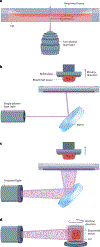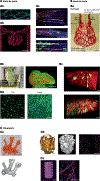Light-based vat-polymerization bioprinting
- PMID: 40909236
- PMCID: PMC12407150
- DOI: 10.1038/s43586-023-00231-0
Light-based vat-polymerization bioprinting
Abstract
Light-based vat-polymerization bioprinting enables computer-aided patterning of 3D cell-laden structures in a point-by-point, layer-by-layer or volumetric manner, using vat (vats) filled with photoactivatable bioresin (bioresins). This collection of technologies - divided by their modes of operation into stereolithography, digital light processing and volumetric additive manufacturing - has been extensively developed over the past few decades, leading to broad applications in biomedicine. In this Primer, we illustrate the methodology of light-based vat-polymerization 3D bioprinting from the perspectives of hardware, software and bioresin selections. We follow with discussions on methodological variations of these technologies, including their latest advancements, as well as elaborating on key assessments utilized towards ensuring qualities of the bioprinting procedures and products. We conclude by providing insights into future directions of light-based vat-polymerization methods.
Conflict of interest statement
Competing interests Y.S.Z. consults for Allevi by 3D Systems and sits on the scientific advisory board and holds options of Xellar, both of which, however, did not participate in or bias the work. R.L. is a scientific advisor for Readily3D SA, which did not participate in or bias the work. The other authors declare no competing interests.
Figures





References
Grants and funding
LinkOut - more resources
Full Text Sources
Other Literature Sources
Miscellaneous
